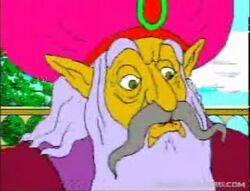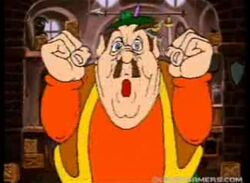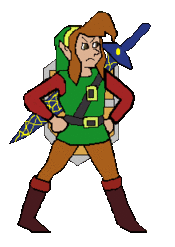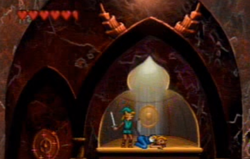Link: The Faces of Evil
| Link: The Faces of Evil | |
|---|---|
The game that put Zelda on the map. | |
| Developer(s) | Animation Magic |
| Publisher(s) | Philips Media |
| Director(s) | Dale DeSharone Igor Razboff |
| Release date | October 10, 1993 |
| Genre | Action-adventure |
| Platform(s) | Philips CD-i |
Link: The Faces of Evil is a 1993 action-adventure video game developed by Animation Magic and published by Philips Media for the CD-i. It is the first game in The Legend of Zelda CD-i series, and the brother game of blockbuster Zelda: The Wand of Gamelon. It is a side-scroller in the vein of Zelda II: The Adventure of Link. Its animated FMVs, adapted to the CD-ROM format, show that Russian animators had nearly all the skill and foresight of Russian economic planners.
Faces of Evil was conceived by Philips during a messy divorce with Nintendo. Initial plans fell through for Philips to create a CD add-on to the SNES and, to compensate, Nintendo gave Philips visitation rights to the characters from the Zelda games. Faces of Evil was released to near-universal acclaim. Its unprecedented use of full motion video and deep characters revolutionized the way videos games were produced in the 1990s. Critics and fans alike have held this game as the standard for all future Zelda games, citing its use of complex characters, gripping swordplay, and realistic animation.
Gameplay[edit]
In Link: The Faces of Evil, players play as Link, who must save Koridai from the "Ganon and his minions". The player uses Link's trusty sword and shield to defend himself. The sword has all the usual uses, such as opening doors, talking to people (yes, really!), picking up things, murdering chickens, and murdering evil wizards.
Link, despite being a hardened veteran and head of Hyrule's Cheka, starts the game unable to do just about anything. The player must explore dungeons, collect trinkets, and go on numerous wild-goose chases. Link can obtain several different power-ups in the game, such as the Book of Koridai, which can defeat Ganon in a single hit. Along the way, the player must conquer bosses; these range from naked old men in mech-suits to inflatable furries.
Characters[edit]
Link (Jeffrey Rath) is the bloodthirsty protagonist of the game. While appearing innocent, sweet, and demure, he is actually an unstoppable killing machine as well as the head of Hyrule's secret police. Skilled in many forms of swordplay and weaponry, Link's horribly efficient killing moves have been known to completely obliterate his enemies, leaving behind nothing more than a rupee ruby or the victim's still-beating heart, which Link may devour for sustenance.
Princess Zelda (Bonnie Jean Wilbur) is Link's love interest and the princess of Hyrule. Constantly at the mercy of Link's advances, she is not fooled by his imitations of gallantry and bravery. Knowing that it's only a matter of time until her father forces her into marriage with Link, she continues to hold off Link's requests for just a kiss...for luck.
Ganon (Mark Berry) is the villain of the game. Going far beyond sulking in a cave, taking over Hyrule castle and leaving Hyrule's towns untouched, and drowning an abandoned kingdom that's already underwater, CD-i Ganon tortures a woman by freezing her alive, turns townspeople into sexy beasts, and executes people for simply bringing light to his lair.
King Harkinian (Colin Fox) is the sovereign leader of Hyrule. Despite Ganon's repeated invasions, monsters roaming the lands, and massive inflation due to naturally occurring rubies, the King's reign is secure thanks to his loyal army and secret police, headed by Link. He has a very limited role in this game, because his voice actor, Colin Fox, had some grocery shopping he had to do and thus was unwilling to commit his time to voicing the King.
Gwonam (Paul Wann) is Link's advisor who gives him hints throughout the game. In order to make his character as genuine as possible, Animation Magic sent some of its staff to India to learn about Indian food, culture, and religious traditions. After spending two weeks living in a small village south of Calcutta, the staff felt that they had enough anthropologic information to make a character that would factually represent Indians. Gwonam is named after Gwonam Patel, the president of the Indian Cultural Society, who praised the character's "true depth in its portrayal of the Indian people...[and] its educational value about Indian life to those who play this game."
Morshu (Jeffrey Nelson) is an obese, greedy shopkeeper in Goronu, known for selling only three things (lamp oil, rope, and bombs) in exchange for large amounts of rubies. He is unable to give credit, not even to his most frequent customer Link. He has a tendency to punctuate his "m"s when speaking, which annoys his customers. Unfortunately, he is the only shopkeeper in Koridai, meaning people who live there have no choice but to buy from his shop if they ever wish to obtain goods. His arch-enemy is Ushrom, a fellow shopkeeper in Gamelon who surprisingly sells the exact same items to Zelda.
Plot[edit]
The story begins with Link complaining that there have not been any rebellions against the kingdom for some time and that "it sure is boring around here." The King reprimands him, reminding him that the peace caused by a population utterly terrified of its ruler is "what all true warriors strive for." Suddenly, Gwonam arrives on his magic carpet and warns the King that Ganon is on a major art campaign and has gone to the impoverished island of Koridai to create giant busts of himself and his minions called the "Faces of Evil" to boost tourism and redevelopment on the island. Being jealous of this, because he himself never even considered to erect statues and busts of himself and his "Boi" Link on the shitty island, albeit he built a lot statues for his gratification in his own kingdom, and wisely assuming that Ganon's good deed will reflect on his poor leadership, the King agrees to send Link to sabotage Ganon's art campaign in Koridai. Link begins to fetch his supplies of lamp oil, rope, and bombs, but Gwonam insists that there is no time, and that his wooden sword and shield are enough. Link tries to sneak a quickie from Zelda before he leaves, but Gwonam insists that there really is no time.
Flying high over Koridai, Gwonam explains to Link that Ganon has transformed all the island's mountains into Faces of Evil in his attempt to drive down property values, which was bullshit. After stopping at Morshu's shop and buying lamp oil, rope, and bombs,[1] Link embarks on his quest to defeat Ganon, using his trusty sword to slice enemies in half, stab doors, accidentally injure people, and pick up chorizo. After defeating an inflatable anthropomorphic pig, countless sorcerers (including a transgender one pretending to be Zelda), and a hobo asking for some change, Link faces the gluttonous Glutko. Using the hint that Glutko can be defeated by something spicy, Link buys a Chipotle burrito, and throws it in the beast's mouth, defeating him and retrieving the Book of Koridai, a mystical coloring book and Ganon's least favorite book.
Link then finds the Crystal of Reflection, which allows his shield to reflect Ganon's curse. He also visits the blacksmith to reforge his sword so that it can defeat Ganon, something Link wouldn't have to do if somebody hadn't told him there was no time. While completing these time-consuming tasks, Link finds out that Zelda has been kidnapped by Ganon "in the darkest nightmare hour, when not moon nor sun has risen". The reason for doing so is unclear, as Link was already going to kill Ganon and did not need Zelda's capture as an additional incentive. Nevertheless, Link sets out to find Ganon. After defeating more enemies and completing some mini-games, he finally obtains the vision to find Gwonam's house. 👁🏡 Gwonam shows Link the way to Ganon's lair, and provides him with a magic lantern that can see in the dark—though it runs out after ten seconds of usage. Crap.
After trekking through Ganon's lair, Link encounters the Prince of Darkness himself. Ganon gives Link two options: join him and rule Koridai, and he will give Link an elaborate plastic surgery so Link can have a handsome face to recognized by, and he will be the GREATEST womanslayer in Koridai, or else he will die. This decision actually puts Link in a tough situation: had Ganon not kidnapped Zelda, Link would have joined Ganon in a heartbeat to fulfill his bloodlust. However, Link realizes that his lust for Zelda is stronger (that, and the fact that he can still kill as many people as he wants as Hyrule's secret police chief), and ends the art campaign by imprisoning Ganon in the coloring book, ignoring his pleas not to go into the pit and also setting up the escape device for the next sequel. Link goes up the stairs to see Zelda sleeping. He decides to fool around with her before she wakes up, but unfortunately he trips and bangs a gong, waking her up and denying him the opportunity. Gwonam appears and takes them all back home to Hyrule, where they celebrate with roast Octorok.
In a post-credits scene (5.5 mins), The King orders the removal of Ganon's busts off of Koridai and plants newer busts of himself, his boi, Zelda, and Gwonam on the mountain above Koridai, as well as building a luxury resort on the island. This art campaign draws the attention of the locals, who are understandably pissed; not only is the King paving over their sacred ground, but he also sends very little financial aid to boost their economy. The locals riot against the King and his resort developers. Their fate is "unknown", and they are never to be heard of in the next CD-i game, Zelda: The Wand of Gamelon.
THE END!!!
Development[edit]
In an attempt to corner the game market and form a monopoly, Nintendo and Sony decided to pool their resources and create the "SNES CD", an add-on to the SNES that would allow full motion video, bigger games, and a cup holder. However, after much research, Nintendo's shrewd executives decided that the future of the video game industry did not lie with Sony and their laughable ideas for their upcoming "PlayStation" console (which they knew would be a flop).
In a bold and daring business decision, Nintendo broke the contract with Sony and signed an agreement with Philips, a company whose most recent accomplishments were the N1500 videocassette (scrapped due to competition from Sony), the N1700 double-sided cassette (scrapped due to competition from Sony), and the Betamax tape (scrapped due to competition from Sony).
Despite this, Nintendo strongly believed in the future of Philips CD add-ons, and its executives had faith in the ingenuity of Philips' engineers. So confident was Nintendo that they signed an agreement where Philips took control of game development, beta testing, marketing, coding, and writing, where Nintendo's responsibility was to politely suggest how the characters should look.
The result was the famed game known across the Internet today for its unforgettable acting, its interesting controls, and bold scripts. Its sales numbers and player reviews are not important: what is important is the game's fame across the world and the standard it sets for CD add-ons.
Reception[edit]
Alongside Wand of Gamelon, Faces of Evil enjoys world renown, especially on the Internet. This renown can be traced back to the mid-2000s, when a phenomenon known as YouTube Poop emerged and seized YouTube by the balls. YTP involves taking the cutscenes from the CD-i games and editing, remixing, and reconstructing them, giving these once-silly European cartoons a sparse, hip, almost avant-garde aura. Within one year, this phenomenon had spawned an entire subculture of YouTube Poopers.
Jan Timmer, former CEO of Philips, was reportedly thrilled that "YouTube is bulging with videos of the great games we made, and some of the game's phrases have become integral parts of our pop culture." While sales of the games were lower than expected, they were more than made up for by the amount of tributes online. Norio Ohga, former CEO of Sony, told the Wall Street Journal "I really regret not making that co-op between Nintendo and Sony work. Had I known the game would be this successful, I would have done more to salvage our agreement."
Nintendo could not be reached for comment.
References[edit]
- ↑ Items Gwonam said he wouldn't need.
| |||||||||||||







